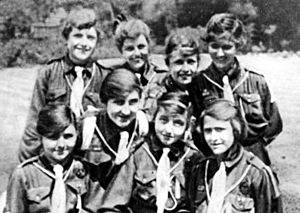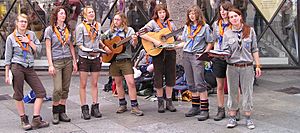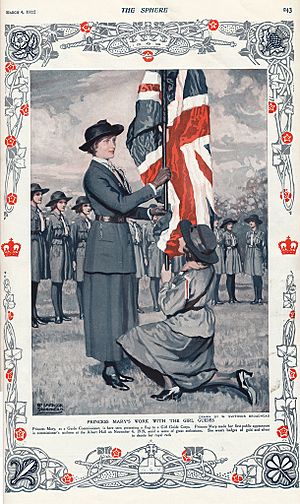Girl Guides facts for kids



Girl Guides or Girl Scouts (as known in the United States) is a movement found worldwide, which was originally and still largely designed for girls and women only. This organisation was introduced in 1909, because girls demanded to take part in the then grassroots Boy Scout Movement.
In different places around the world, the movement developed in diverse ways. In some places, girls joined or attempted to join Scouting organisations. In other places, girls' groups were started independently, some of them later opening up to boys or merging with boys' organisations. In other instances, mixed groups were formed, sometimes to later split. In the same way, the name Girl Guide or Girl Scout has been used by groups at different times and in different places, with some groups changing from one to another.
The World Association of Girl Guides and Girl Scouts (WAGGGS) was formed in 1928 and has member organisations in 145 countries. There are now more than 10 million members worldwide. WAGGGS celebrated the centenary of the international Girl Guiding and Girl Scouting Movement over three years, from 2010 to 2012.
History
Lieutenant-General Robert Baden-Powell was a British soldier during the Second Anglo-Boer War in South Africa (1899–1902). He was the commander during the Siege of Mafeking, and noted during the siege how young boys made themselves useful by carrying messages for the soldiers. When he came home, he decided to put his Scouting ideas into practice to see if they would work for young boys, and took 21 boys camping on Brownsea Island, near Poole in Dorset. The camp was a success, and subsequently Baden-Powell wrote the book Scouting for Boys. The book covered topics such as tracking, signalling, and cooking, and it outlined a Scout method for an "instruction in good citizenship". Soon boys began to organise themselves into Patrols and Troops and calling themselves "Boy Scouts". Girls bought the book as well and formed themselves into Patrols of Girl Scouts, while some girls and boys formed mixed Patrols.
In those days, for girls to camp and hike was not common, as shown by this excerpt from The Boy Scouts Headquarters Gazette of 1909: "If a girl is not allowed to run, or even hurry, to swim, ride a bike, or raise her arms above her head, how can she become a Scout?" Nevertheless, Girl Scouts were registered at Scout Headquarters. In 1909 there was a Boy Scout rally at Crystal Palace in London. Among the thousands of Boy Scouts at the rally were several hundred Girl Scouts, including a group of girls from Peckham Rye who had no tickets. They asked Baden-Powell to let them join in. Following negative publicity in "The Spectator" magazine Baden-Powell decided that a separate single-sex organisation would be best. Baden-Powell asked his sister, Agnes Baden-Powell, to form a separate Girl Guides organisation. In 1910 The Girl Guides were officially formed in the United Kingdom. The first Guide Company to be registered was 1st Pinkneys Green Guides (Miss Baden-Powell's Own), who still exist in Pinkneys Green, Maidenhead, Berkshire. Many, though by no means all, Girl Guide and Girl Scout groups across the globe trace their roots to this point.
Baden-Powell chose the name "Guides" from a regiment in the British Indian Army, the Corps of Guides, which served on the Northwest Frontier and was noted for its skills in tracking and survival. In some countries, the girls preferred to remain or call themselves "Girl Scouts".
Other influential women in the history of the movement were Juliette Gordon Low, founder of the Girl Scouts of the USA, Olga Drahonowska-Małkowska in Poland and Antoinette Butte in France.
Guide International Service
The Guide International Service (G.I.S.) was an organisation set up by the Girl Guides Association in Britain in 1942. Their aim was to send teams of adult Girl Guides to Europe after World War II to aid with relief work. It is described in two books: All Things Uncertain by Phyllis Stewart Brown and Guides Can Do Anything by Nancy Eastick. A total of 198 Guiders and 60 Scouts, drawn from Britain, Australia, Canada, Ireland and Kenya, served in teams. Some went to relieve the Bergen-Belsen displaced persons camp, while others served in Malaya.
Key points
Things that are shared amongst all Guide Units are:
- The Guide Promise – Girls become Guides by making their Promise. Each country has its own Promise, but historically all have the same three parts: duty to God or to your beliefs, duty to your country and keeping the Guide Law. Though there was historically a religious aspect, many countries are moving towards more non-denominational promises.
- The Good Turn – Each Guide tries to do a kind thing for someone else, without payment and without being asked, every day.
- The World Badge – This can be worn on uniform or ordinary clothes. The three leaves of the trefoil stand for the threefold Promise. The vein in the centre is a compass needle, pointing the way and the two stars stand for the Promise and the Law. The colours stand for the golden sun shining over all the children of the world, from a blue sky. This badge is a guiding symbol that can be recognized all over the world.
- The World Flag – This is in the same colours as the World Badge and can be carried or flown by any member of the movement. It is often used as the Unit Flag. The three yellow blocks represent the threefold Promise and the white corner represents the commitment to peace of all WAGGGs' members.
- The Guide Sign – The three fingers stand for the three parts of the Promise. The Guide sign is used when making or renewing the Promise and can be used when meeting other Guides. It may also be used when receiving a badge or at the end of meetings.
- The Motto – "Be Prepared" – This means that Guides are ready to cope with anything that might come their way.
- The left handshake – This is the way members of the Movement greet each other. The left hand is the one nearest the heart, so symbolizing friendship. Additionally, warriors held their shield in the left hand, so putting down your shield means that you are vulnerable, making it a display of both bravery and trust.
- Thinking Day – On February 22 each year, Guides think of their Guide sisters all around the world. The date was chosen at a World Conference because it was the birthday of both the Founder and the World Chief Guide.
- The World Centres – There are five World Centres in different parts of the world: Our Chalet in Switzerland; Pax Lodge in London; Our Cabana in Mexico; Sangam in India; and Kusafiri in Africa.
- The World Chief Guide – Olave, Lady Baden-Powell is the only person ever to have been World Chief Guide. She was the wife of the Founder, Lord Baden-Powell of Gilwell, and lived from 1889 to 1977.
Two central themes have been present from the earliest days of the movement: domestic skills and "a kind of practical feminism which embodies physical fitness, survival skills, camping, citizenship training, and career preparation". These two themes have been emphasized differently at different times and by different groups, but have remained central to Girl Guiding and Girl Scouting.
Uniforms
Individual national or other emblems may be found on the individual country's Scouting article.
The uniform is a specific characteristic of all Scouting movements. Robert Baden-Powell said it "hides all differences of social standing in a country and makes for equality; but, more important still, it covers differences of country and race and creed, and makes all feel that they are members with one another of the one great brotherhood".
In the 1909 The Scheme for Girl Guides, the uniform for the newly emerging movement was given as:
Jersey of company colour. Neckerchief of company colour. Skirt, knickers, stockings, dark blue. Cap – red biretta, or in summer, large straw hat. Haversack, cooking billy, lanyard and knife, walking stick or light staff. Cape, hooked up on the back. Shoulder knot, of the 'Group' colour on the left shoulder. Badges, much the same as the Boy Scouts. Officers wear ordinary country walking-dress, with biretta of dark blue, white shoulder knot, walking stick, and whistle on lanyard.
Guide uniforms vary according to cultures, climates and the activities undertaken. They are often adorned with badges indicating a Guide's achievements and responsibilities. In some places, uniforms are manufactured and distributed by approved companies and the local Guiding organisation. In other places, members make uniforms themselves.
See also
 In Spanish: Guidismo para niños
In Spanish: Guidismo para niños


